Kontea Heritage Project
Turkmenkoy, North Cyprus
 |
| Agios Charalambos, Kontea, Cyprus |
The village of Turkmenkoy, still frequently called by its original name of Kontea, is on the old Nicosia/Famagusta road, situated on the edge of the Meserya plain. Before 1974 the inhabitants were Greek Cypriots, moving moved to the south in 1974, being replaced by Turkish Cypriots who had left their southern villages. It's not far from the crossing point at Pile, and is one of the villages that would have been returned to southern Cyprus had the Annan Plan gone ahead.
When the crossing points were opened in 2004, some of the displaced inhabitants took the opportunity to visit their former village, and friendships developed because of the shared experiences of the old and new inhabitants. One area of common concern was the possible loss of their shared cultural heritage.
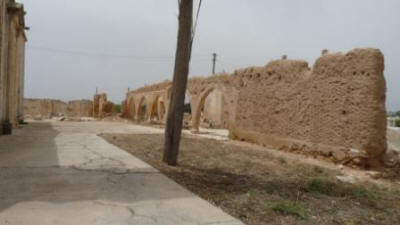 |
| The Church Outbuildings |
To the south of the village, and probably unique in Cyprus, within a 200 yard radius there is a Lusignan mansion, a system of medieval cisterns and aqueducts, a Catholic chapel, a Greek Orthodox church, the original village primary school, and a modern mosque. Several of those buildings were (and still are) suffering from the ravages of time, and are in danger of being lost forever, and the new-found friends felt that their preservation would be an example to the rest of the island. As far as is known, this is the only bi-communal collaboration launched by the residents themselves.
 |
| The First Primary School of the Village |
The first stage, however, was not these buildings, but at a carob plantation a little further to the south. In 1965, 1100 carob trees had been planted in a stony area not suitable for other crops. Funded by the UNDP-ACT, work has been done to convert this into a "peace park" and picnic area. Former and current residents have volunteered their services for the future maintenance and upkeep of this park, which was officially opened by the US ambassador to Cyprus in May 2010.
The bulk of the project, however, will be on the buildings, and a start has been made on the Greek church. The current building is single-aisled and cross-vaulted. Inaugurated in 1876, it stands on the site of two previous churches, the first one thought to have been built in 1570, the year before the Ottomans arrived. It is the only church dedicated to St Charalambos in the Famagusta region, and was a popular point for the celebration of the Saint's feast day on the 10th February. The church is fairly well preserved, although there are some signs of damp penetration through the solid walls.
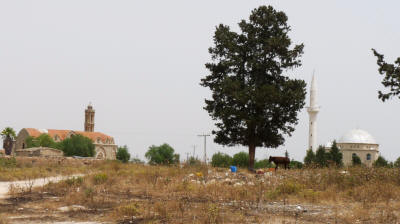 |
| The Area Between Church and Mosque to be cleared |
On two sides of the church courtyard there were buildings which served as a covered market and meeting place for the village. The two ends and the corners were enclosed in order to provide lodging for travellers and visitors. This range of buildings is in a sad state of repair, and all that can be seen now are the stone arches.
North of the church is the original primary school of the village. This is well preserved, as it has been in continuous occupation.
The mosque is to the south of the church, with the mansion and chapel ruins to the southwest. This triangular piece of land is little more than scrub, and has been used a dumping ground for all sorts of rubbish. The next phase, therefore, is to clear and improve this area.
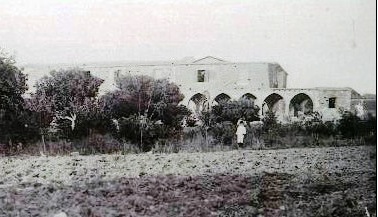 |
| The Lapierre Mansion at the end of the 19th Century |
On a longer timescale (and the villagers didn't disagree when I suggested it could take 10 years), is the renovation of the mansion, chapel and aqueduct. The most difficult, but possibly the most important for the island's heritage, is the restoration (or halting the decline) of the mansion. Negotiations are underway with the current occupier of the mansion ruins, who uses them to house a herd of goats. Fortunately, although it is in ruins, the mansion was of such importance, that extensive records of it remain.
The original mansion was built during Lusignan times, and was the home of a Viscount, a corruption of which gave the name of the village. It was built on an elevated position overlooking the Meserya plain, to the southwest of the position where the Greek church would eventually be built. It had a large inner courtyard, with arched doorways leading to reception rooms. Originally a Frankish fief, it gradually grew into a small village because of the manpower needed to farm the land. After the Ottomans arrived, it fell into the hands of the Kykkos monastery and then to the Archbishopric of Cyprus. In 1797, the mansion was extensively renovated, and a plaque placed on the building at the time. This has been translated into English by Charalambos Pericleous, President of the Kontea Heritage Foundation, and reads:-
THE BEAUTY OF THE RICH AND
FERTILE LAND
ADMIRE OH VISITANT! WELL AND DIVINELY GIFTED IT IS.
SWEET WATER IN PLENTY FLOWING OVER THE DUCT
PASTURES GREEN AND ORCHARDS REFRESHING
THE AIR IN MELODY BLOWING, FEEL THE MILD BREEZE!
JOY TO THE HEART AND TO THE EYE THIS PLACE BRINGS
KONTEA IS THE NAME AND RIGHTFULLY DESERVES THE FAME.
HERE FLOWERS AND GARDENS BLOSSOM AND TREES LIKE FORESTS GROW
YET THIS PLACE WAS NOT SO BEFORE, THIS MANSION NOW WELL IS DECORATED
NOW IN ORDER IS ALL, A BEAUTY AND A WONDER!
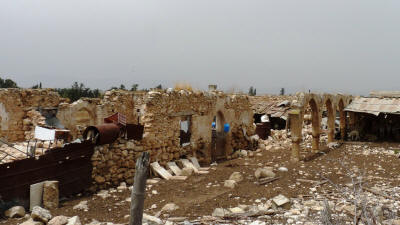 |
| The Lapierre Mansion as it is Today |
In 1823, Archbishop Joacham sold the property to George Lapierre for 15,000 piastres. This was possibly in an attempt to prevent church lands falling into the hands of the Ottomans following the start of the Greek War of Independence. It consisted of 696 acres of land, 77 olive trees, fig trees, and mulberry trees, 258 animals, and 29 stables and barns. The fertility of the soil meant that farming was an attractive proposition, and the village gradually expanded on the edge of the mansion lands.
The Lapierre family were well-known and respected by the Ottomans. They were of French/Italian extraction, and an ancestor, Pierre Antoine Agnesi-DeLaPierre was known to be in Constantinople in the 1720s. His son and grandson were multi-lingual, and acted as translators to the French diplomat, Talleyrand. At some time in the mid 1700s, they moved to Cyprus to act as Dragomen to the Ottoman administration.
This was a key position. The dragoman would act as an interpreter and guide between the various Turkish, Arabic and Persian speaking countries and the Middle East and European embassies, consulates and trading posts. They had to have knowledge of Arabic, Turkish and European languages and customs.
 |
| Medieval Aqueduct |
Passing the front of the mansion and Catholic chapel, you can see the remains of the irrigation system. It consisted of a series of cisterns and aqueducts. These were in use well into the 1960s, and could be easily renovated. On my visit, I was told that the water came from the Troodos mountains, but I think that is unlikely when you think that the water for Salamis came from Digermenlik (Kythrea), which is less than a third of the distance. However the aqueduct is running in from the south, so I suspect that the source was in the hills between Larnaca and Nicosia, which would be a similar distance.
In the 1840s, with funds from Jerusalem, the Lapierre family built the catholic chapel, which was dedicated to St Anthony. There are only some walls remaining, but fortunately there is good photographic evidence of how it once looked. It is expected that the renovation of the chapel and irrigation system will be started after the church buildings have been completed. Close to it is small graveyard where members of the Lapierre, and latterly the Diacono families are buried. The latest date I could see here was 1965.
 |
| The Chapel Built by the Lapierre Family |
Frederico Roberto Diacono was born in Alexandria on the 9th May 1854 to an Anglo/Maltese family. He was one of 13 children, of whom only 6 survived into adulthood. In 1874, Frederick (with his new anglicised first name) was in London on family business, and met his first wife, Louisa, marrying on her 21st birthday in 1876. Their child, Cora, was born on the 1st January 1878.
On their journey back to Alexandria in 1879, Louisa died at sea on the 30th August. Leaving his daughter with her grandparents in Alexandria, Frederick found himself in Cyprus where he met Virginie Lapierre who he married on the 13th June 1880, less than a year after the death of his first wife.
In 1881, the Orbi Revolution in Egypt caused Cora and her grandparents to flee to Malta, and in 1882 Frederick went to Malta in order to bring her back to Cyprus, where just 6 weeks later on the 11th March 1882, Frederick and Virginie's daughter, Edmee, was born.
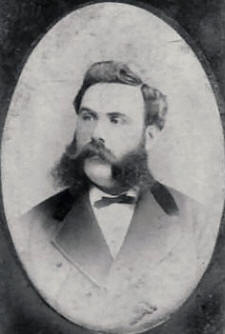 |
| Frederick Diacono |
1884 saw the family back in Egypt, where their first son, Louis, was born, later to be followed by a second, Joseph, in 1887. But it was not a happy family. Cora and her step-mother never got on, and this cumulated in an incident that saw Cora "fall" down a flight of stairs, breaking her ankle, an injury that never properly healed and left her with a foot that was permanently turned inwards. The situation didn't improve, and in 1885, Frederick took his daughter to England to live with her paternal grandmother. She never saw her father, or any member of her immediate Diacono family again.
In 1892, Frederick, and his father, Joseph, were working in the Suez office of the Credit Lyonnais bank, who brought a legal action against them for embezzlement. The trial was scheduled for the 17th may 1893, but there are no records of it having taken place. What is known, however, is that Fredericks sister, who was only 22 and single put up a bond of £400 for the release on bail of her father and brother. This was a considerable sum for a person who's only income was from teaching to find, around £35,000 in today's money, and about three times her annual income. There is some thought that the money was intended to be forfeited to Credit Lyonnais as a "get out of jail" fee.
 |
| The Lapierre and Diacono Family Graves Close to the Chapel |
However they managed it, Frederick Diacono and his family returned to the Lapierre estate in Cyprus. He was well respected in Kontea, and died in 1898, aged just 44, from a chest infection that developed into pneumonia. He was buried in the family graveyard, close to the chapel, and was joined in by his son Joseph in 1905. However, he had to wait for nearly 40 years to be re-united with his wife Virginie, who died in 1937. They were finally joined by their son Louis in 1965. Descendents of Louis still live in Nicosia.
During the first half of the 20th century, the mansion gradually fell into disrepair, and it was finally abandoned around the time of Louis' death.
The Kontea Heritage Project is destined to be long term, and is one that is uniting communities from both sides of the green line. The day I visited, three coach loads of visitors arrived for the opening of the peace park, and to look at the progress made on the project. Everybody I spoke to was proud of what they hoped to achieve, and felt that it was a fine example of inter-communal cooperation, irrespective of what side of the border Kontea finally ends up on.
Update, February 2014.
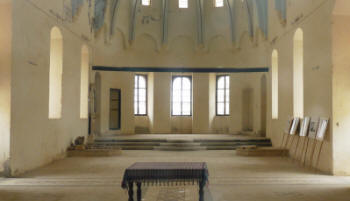 |
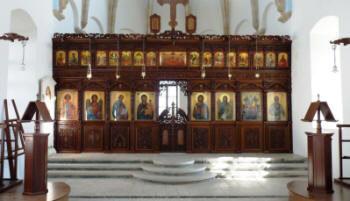 |
| The church interior, May 2010 | The church interior, February 2014 |
Three and a half years on, I took 2 friends to look at what progress had been made.
Disappointingly, the church was all locked up, but over a cup of Turkish coffee at the village coffee shop, we were spotted.
A phone call was made to a local key holder, and 10 minutes later he duly arrived to open the church for us.
The renovation of the church is now complete. An impressive iconostasis has been put in place. The intricate wood carving for this having been done locally.
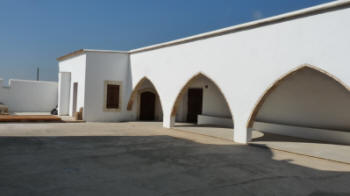 |
| The renovated outbuildings |
The interior has now been completely refurbished and decorated.
The church outbuildings, likewise, have been rebuilt, and all walls surrounding the church are now painted a brilliant white.
Although the original inhabitants live in the south, they frequently return to the village, and the church, while not used every Sunday, does see regular services. A few days before our visit, there had been over a thousand worshipers attending a service.
Away from the church, about 500 meters south, the picnic area and children's playground are proving to be well used.
There is still a long way to go to totally renovate the heritage of this village, but a good start has been made.
See the location on Google maps.
Back to Famagusta index.